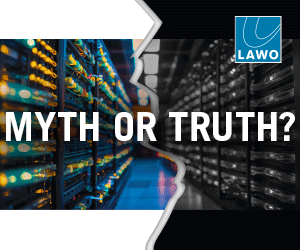JPEG 2000 versus MPEG versus uncompressed. Jean-François Nivart explores the difference As images have such a ubiquitous and important place in our lives, this industry is continuously seeking ways to improve image quality. We have become used to high-quality pictures, and we now expect the quality to rise as technology evolves. But this evolution is generating […]

JPEG 2000 versus MPEG versus uncompressed. Jean-François Nivart explores the difference
As images have such a ubiquitous and important place in our lives, this industry is continuously seeking ways to improve image quality. We have become used to high-quality pictures, and we now expect the quality to rise as technology evolves. But this evolution is generating a drastic increase of picture data volume. We can anticipate an explosion of image data by a factor of 50 or more within the next 10 years.
Compression is the key to dealing with this explosion in data volumes while increasing visual quality. The choice of compression method at each stage of the chain from origination to distribution is critical to both efficiency and quality; and with the recent advent of JPEG2000 technology, theres a clear decision to be made about which compression methods are appropriate for post-production and distribution stages.
Despite the rapid increase in communication technology, we are struggling with data volume not so much because we are missing storage capacity (data storage costs have never been so low) or because bandwidth is in short supply (in fact, its expanding dramatically with fiber connections). The pressure is really created by the explosion of multiple audiovisual content offerings and the demand for ever more varied sources, formats, viewing devices, interactivity and on demand consumption.
Over the past decade, the industry has focused on increasing accessibility to content. Now, there is a new emphasis on fostering the quality of the content that technology has made accessible so widely. And as images represent the major component in audio-visual data volumes, image compression technologies are becoming more significant.
The goal of providers is still to prepare audio-visual content for consumption in any format, on any screen, at any time, through any channel; but now and increasingly into the future, providers will look for more control over the viewing quality.
As they move along the production chain, images are submitted to a series of transformations through the stages of origination, contribution, post-production and distribution. Due to data volume constraints, images are decompressed and compressed at the input and output of each transformation. Without care, the images degrade rapidly through the multiple generations of encoding and decoding.
The main contenders for the encoding-decoding crown are MPEG AVC, MPEG-HEVC, and JPEG 2000, together with proprietary compression methods developed by a variety of manufacturers. But fundamentally, there are two approaches to compression. On one side, there is visual compression, and on the other, there is structural compression.
JPEG 2000, with its wavelet transform, is a structural compression method. Structural compressions simply re-organise the image data according to its contribution to the global information in the picture and then throw away the less significant data packets.
By contrast, the MPEG compression family uses a visual compression model. Visual compression takes into account the particularities of human vision to remove from the data set all the details eyes cannot see.
Evaluated solely in terms of the viewer, visual compression is more efficient than structural compression.
But when the image is destined to be post-processed or analysed, a structural compression approach protects image details that could be essential in the subsequent use and processing of the image.
For this reason, JPEG 2000 is the preferred format for medical pictures, space and earth sensing imagery, and military applications, while MPEG is used in broadcast and streaming to viewers.
The question today is: how can we use these different qualities of compression to achieve our goals? How can we best protect picture quality along the production path in order to optimise its final usage on every screen, format and at any time? In other words, within the context of broadcast and cinema production, how can we best take advantage of the emerging JPEG 2000 technology to improve the quality of service to viewers?
To achieve that goal of increasing visual quality at the consumption end of the chain, we have to protect the image structure all along the production path, from the sensor till the final stage of distribution. If we use an image compression method that respects the intimate structure of the image, we will be able to apply as many image processing stages as needed, without reducing the essential image quality.
The JPEG 2000 codec performs well through multiple compression-decompression cycles and presents little interference with image processing. MPEG codecs, on the other hand, are very sensitive to multiple generations and to inter-generation processing. So JPEG 2000 image compression is recommended for all intermediate steps of the production chain.
Why not simply use uncompressed data all along the production chain? This would perfectly protect image structure, but unfortunately, uncompressed data generates a huge volume of data and is not flexible: with uncompressed data, you cannot adapt your chains performance to the content quality it is everything or nothing. And with beyond HD looming on the horizon, the potential for data volumes to expand exponentially is already a reality.
Here again, JPEG 2000 offers the flexibility the industry requires. It can be applied at any of the usual intra-frame compression rates, typically 10:1 to 20:1, rising all the way to a perfect mathematically lossless mode at 2:1 compression rate. JPEG 2000, therefore, has the power to protect the ultimate quality while at the same time, offering these compact, visually lossless modes.
In conclusion, while in an ideal world, uncompressed images would be the perfect way of preserving the image essence through the production chain, the reality of drastically increasing data volumes and the need for production flexibility makes it impossible to operate this way. For real-world image data volumes, JPEG 2000 provides an excellent alternative with a high level of flexibility and quality-preservation right up to the head-end, where the MPEG codec can be deployed to cover the last miles to the viewer.
Jean-François Nivart is CEO of Image Matters












































































